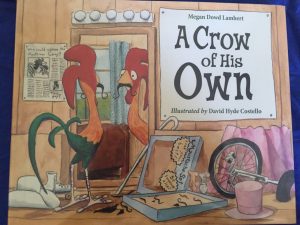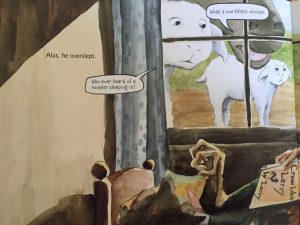Author: Megan Dowd Lambert
Illustrator: David Hyde Costello
Publishing Information: Charlesbridge, 2015.
Number of Pages: 30
Genre: Fiction, Picture book


Analysis:
Clyde is new to Sunrise Farm after the former legendary rooster Larry leaves. He tries everything to gain popularity in the farm but never succeeds even once. With the help of the motherly goose Roberta, Clyde finally decides to be himself and calls out a crow of his own.
The book tells a story about an outsider trying to fit in. The text serves as both a window and a mirror for readers. It allows children to look at an interesting story on the farm and at the same time have some takeaways. The character Clyde is a typical figure who wants attention and popularity but keeps improperly belittling himself.
There is one plot which I found unnecessary. Roberta the motherly goose explains to Clyde why everyone else doesn’t talk to him. Not only does Clyde misspell her name, but he also does not show any appreciation to Roberta. Younger readers might think it is okay to take other people’s help for granted. The other thing I found problematic about this book is that Clyde always tries to impress everyone else. Although in the end he decides to call out his own crow, the reason he makes that decision is still to gain other people’s attention. Children should know that it is important to be themselves. Besides, I think the author should elaborate more about why the other animals despise Clyde. They look down on him not because his lack of talent, but because of his shortcomings which he could totally overcome by himself. For example, Clyde is shy and always tries so hard that he make a scene himself every time. He has his chances but he oversleeps and forgets to crow.
Perceptually, the book uses a lot of bright colors to depict the peaceful atmosphere on the farm. There are some dialog boxes in the illustrations which show readers the conversations directly. The images are not framed. Therefore, readers can actually participate in the story. Structurally, text and images overlaps. Ideologically, the book teaches children to be themselves. Everyone has his or her own advantages. Be brave and keep trying, then you will succeed.
